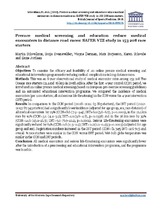| dc.contributor.author | Schwellnus, Martin | |
| dc.contributor.author | Swanevelder, Sonja | |
| dc.contributor.author | Derman, Wayne | |
| dc.contributor.author | Borjesson, Mats | |
| dc.contributor.author | Schwabe, Karen | |
| dc.contributor.author | Jordaan, Esme | |
| dc.date.accessioned | 2018-11-22T07:21:47Z | |
| dc.date.available | 2018-11-22T07:21:47Z | |
| dc.date.issued | 2018 | |
| dc.identifier.citation | Schwellnus, M. et al. (2018). Prerace medical screening and education reduce medical encounters in distance road races: SAFER VIII study in 153 208 race starters. British Journal of Sports Medicine, 2018. | en_US |
| dc.identifier.issn | 0306-3674 | |
| dc.identifier.uri | http://dx.doi.org/10.1136/bjsports-2018-099275 | |
| dc.identifier.uri | http://hdl.handle.net/10566/4221 | |
| dc.description.abstract | OBJECTIVES To examine the efficacy and feasibility of an online prerace medical screening and educational intervention programme for reducing medical complications in long-distance races.
METHODS This was an 8-year observational study of medical encounter rates among 153 208 Two Oceans race starters (21.1 and 56 km) in South Africa. After the first 4-year control (CON) period, we introduced an online prerace medical screening (based on European pre-exercise screening guidelines) and an automated educational intervention programme. We compared the incidence of medical encounters (per 1000 starters; all and serious life threatening) in the CON versus the 4-year intervention (INT) period.
RESULTS In comparison to the CON period (2008–2011: 65 865 starters), the INT period (2012–2015: 87 343 starters) had a significantly lower incidence (adjusted for age group, sex, race distance) of all medical encounters by 29% (CON=8.6 (7.9–9.4); INT=6.1 (5.6–6.7), p<0.0001), in the 21.1 km race by 19% (CON=5.1 (4.4–5.9); INT=4.1 (3.6–4.8), p=0.0356) and in the 56 km race by 39% (CON=14.6 (13.1–16.3); INT=9.0 (7.9–10.1), p<0.0001). Serious life-threatening encounters were significantly reduced by 64% (CON=0.6 (0.5–0.9); INT=0.2 (0.1–0.4); p=0.0003) (adjusted for age group and sex). Registration numbers increased in the INT period (CON=81 345; INT=106 743) and overall % race starters were similar in the CON versus INT period. Wet-bulb globe temperature was similar in the CON and INT periods.
CONCLUSION All medical encounters and serious life-threatening encounters were significantly lower after the introduction of a prescreening and educational intervention programme, and the programme was feasible. | en_US |
| dc.language.iso | en | en_US |
| dc.publisher | BMJ Publishing Group | en_US |
| dc.rights | This is the post-print version of the article published online at: http://dx.doi.org/10.1136/bjsports-2018-099275 | |
| dc.subject | Online prerace medical screening | en_US |
| dc.subject | Educational intervention programme | en_US |
| dc.subject | Reducing medical complications | en_US |
| dc.title | Prerace medical screening and education reduce medical encounters in distance road races: SAFER VIII study in 153 208 race starters | en_US |
| dc.type | Article | en_US |
| dc.privacy.showsubmitter | FALSE | |
| dc.status.ispeerreviewed | TRUE | |

